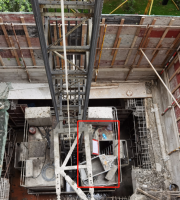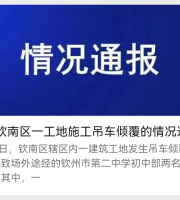Professional bidding document making, engineering budget, engineering cost 16 years old brand, for your bidding escort, winning the bid is to give you the best service! Source: the copyright of the network belongs to the original author
.
The construction method of the concrete anti-collision guardrail
.
At present, the bridge anti-collision guardrail adopts the cast-in-place reinforced concrete scheme
.
The appearance quality of the anti-collision guardrail is mainly divided into the linear appearance quality and the concrete wall appearance quality, and the linear appearance is divided into the plane linear appearance and the longitudinal linear appearance
.
The main determinants of linear appearance quality are measurement accuracy and formwork support accuracy, while the appearance quality of concrete wall mainly depends on the dynamic quality of concrete mix proportion, mixing, pouring, vibration and other construction processes
.
In order to solve the common quality problems in the construction of concrete anti-collision guardrail and improve the internal quality and appearance quality of concrete anti-collision guardrail, strict quality control should be carried out from the measurement and setting out, steel bar processing and installation, formwork production and installation, concrete mixing and pouring, curing and other construction links
.
The operation points of each link of construction technology are as follows: 1
.
Template making is the basis to ensure the size and appearance quality of each part of the anti-collision guardrail
.
From the beginning of template making, we should have high standards and strict requirements
.
The construction of anti-collision guardrail adopts customized special steel formwork, which has the advantages of large rigidity, good flatness, and not easy to deform
.
It is not easy to deform in the process of use, and can ensure that the concrete surface is smooth and smooth, and the lines are straight
.
Secondly, the turnover times of steel formwork is more, and the long-term benefit is good
.
The die surface steel plate is made of 5mm thick new steel plate, which has good integrity
.
Each steel formwork of anti-collision guardrail is 1.25m long along the bridge, and the spacing of stiffening ribs outside the formwork is about 30cm, mainly to ensure that the formwork is not easy to deform in the process of use and hoisting
.
The 5 engineering WeChat official account is based on actual combat, and is practical and worthy of attention
.
After the fabrication of steel formwork, trial assembly shall be carried out before formal use, mainly to inspect the overall effect of formwork installation, whether the formwork joints are smooth, and whether there are gaps and staggered platforms
.
It can only be used after passing the inspection, otherwise relevant correction shall be carried out
.
In order to better ensure the appearance of the concrete anti-collision barrier linear straight, we must pay attention to the accuracy and accuracy of the plane position measurement lofting
.
The total station is used to accurately loft the plane position of the inner edge line of the anti-collision guardrail
.
A point is placed every 3M along the longitudinal direction of the horizontal curve, and a point is placed every 5m along the longitudinal direction of the straight line
.
The corresponding point position of the outer edge line is determined by measuring the design width of the guardrail according to the inner edge line
.
Using ink line to connect the longitudinal snap line of the lofting point as the inside and outside installation sideline of the formwork can better control the installation line of the guardrail formwork
.
If the longitudinal alignment is not smooth and straight, and there is obvious inflection point or broken line in visual inspection, it must be retested to find out the cause and fine-tuning
.
3、 In order to facilitate the construction of formwork base, the current design recovers the outer side line of the anti-collision guardrail to the bridge by 9.7cm
.
If the outer formwork is directly placed on the top surface of the beam slab and the inner formwork is placed on the concrete base (poured together with the deck pavement and the same height), the elevation difference between the top of the inner and outer formwork will occur, so the installation of the outer formwork must be laid within the range of 9.7cm The support base (referred to as the template base) refers to the already laid level control points, measures the elevation of the inner and outer sides of the bottom of the anti-collision guardrail, compares it with the design elevation, and calculates a reasonable elevation difference value according to the elevation difference and the longitudinal slope of the bridge, which is used to determine the top elevation of the template base
.
The top surface of the 9.7cm beam plate extending from the outside of the anti-collision guardrail is made of the outer template base with the mortar of m10and the inner template is directly made of the deck pavement as the base
.
The elevation of the inner and outer bases should be controlled accurately
.
Before the installation of the formwork, a thick double-sided adhesive tape shall be pasted at the bottom to seal the joint between the formwork and the base to prevent slurry leakage
.
4、 Due to the small section size of the anti-collision guardrail, the processing and installation accuracy of the reinforcement is required to be higher
.
The experienced reinforcement workers must operate in strict accordance with the requirements of the drawings and specifications to ensure that the total quantity, spacing size and connection quality of the reinforcement meet the requirements
.
Before the installation of reinforcement, the concrete top surface of the anti-collision guardrail base shall be cleaned, the laitance shall be chiseled and washed with high-pressure clean water
.
Then, the installation position of the embedded reinforcement should be adjusted according to the position of the inner and outer side lines of the crash barrier
.
Install plastic cushion block to ensure the thickness of concrete cover
.
When connecting the reinforcement according to the requirements of the drawing, we must pay attention to the connection quality of all reinforcement
.
If single-sided lap welding is adopted, the welding seam shall be full, the welding slag shall be removed, and the lap length shall be appropriate; if binding connection is adopted, the lap length of binding shall not be less than 35d, and each lap of reinforcement shall be bound with three binding wires
.
The reinforcement along the bridge must be disconnected at the expansion joint or broken joint, and the rest parts shall not be disconnected
.
Steel bar processing of anti-collision guardrail v
.
formwork installation: before the formal installation and use of steel formwork, the surface mortar, cement slurry, floating rust and other pollutants shall be removed, polished with polishing machine, and the formwork surface shall be evenly coated with release agent, so as to ensure the smooth concrete surface and the concrete does not stick to the formwork
.
A row of reinforcement earrings with a spacing of 60cm are embedded along the bridge deck pavement 50cm from the inner side of the anti-collision guardrail as the fixed point of the formwork
.
The inner formwork and the reinforcement of the embedded earrings are fastened with orchid wire
.
After the formwork is removed, the reinforcement Earrings shall be removed close to the bridge deck
.
The template installation personnel shall be familiar with the process and quality requirements of this work project
.
When installing the inner and outer formwork, it is necessary to keep close to the concrete base and connect them tightly with bolt tie rods
.
One tie rod is set at the bottom and one at the top respectively
.
The spacing of tie rods along the bridge direction is 85CM
.
When the formwork is installed, the inner and outer bottom lines must be consistent with the setting out ink line of the anti-collision guardrail, and a broken joint shall be set every 8m (or 10m) along the bridge direction
.
The fracture joint is fixed by two pieces of broken steel template and foam board in the middle
.
The width of the fracture is 2cm, and 8 20cm long steel bars on each side are welded on the skeleton to be fixed
.
During construction, attention should be paid to pouring concrete on both sides of the broken joint at the same time to prevent the bending deformation of the side formwork caused by extrusion on one side
.
Double sided adhesive tape shall be pasted between formwork joints to prevent slurry leakage
.
Pay attention to reserve the drain pipe channel when installing the formwork
.
The broken steel plate and the intermediate sandwich foam template are reinforced by the external formwork of the broken joint, and the concrete pouring is used to control the concrete dosage according to the construction mix proportion
.
The concrete shall be mixed with forced mixer, and the water consumption and mixing time shall be strictly controlled
.
The mixing time shall be controlled at 1.5min
.
The concrete shall be evenly mixed, the slump shall meet the requirements, and the workability shall be good
.
The slump of concrete should be controlled at about 90mm
.
The concrete is transported to the site by the concrete transport truck, loaded into the formwork by the chute, and vibrated by the plug-in vibrator
.
During the concrete construction of the anti-collision guardrail, the concrete between two adjacent broken joints is taken as a pouring unit, and each pouring unit is poured in three layers at a time, so as to avoid or reduce the defects such as bubbles and water marks at the chamfer of the anti-collision guardrail
.
The concrete pouring starts from one end and advances horizontally and obliquely
.
The concrete pouring height of the lowest layer reaches the first corner of the lower part of the inner formwork, the concrete pouring height of the second layer reaches the second corner of the inner formwork, and the concrete of the third layer is directly poured to the top surface
.
During the concrete vibration, attention shall be paid to the dense vibration
.
The vibration time of each rod shall not be less than 1 min and not more than 1.5 min
.
attention shall be paid to prevent the phenomenon of missing vibration and over vibration
.
When the upper layer of concrete is vibrated, the vibrator shall be inserted into the lower layer for about 5-10 cm, and the upper layer of concrete shall be poured before the initial setting of the lower layer of concrete
.
The plug-in vibrator shall be fast in and slow out, and the vibrator shall not collide with the formwork and reinforcement
.
The concrete shall be vibrated until the surface is full of slurry, no bubbles will appear and the surface will not sink
.
In case of slurry leakage during vibration, it shall be timely blocked and vibrated to avoid honeycomb after formwork removal.
.


